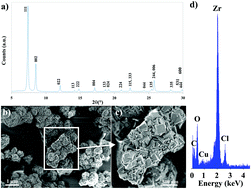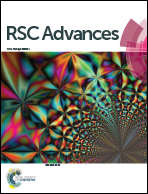Synthesis of zirconium oxycarbide powders using metal–organic framework (MOF) compounds as precursors
Abstract
ZrCxOy oxycarbides were synthesized for the first time by using metal–organic framework (MOF) compounds as precursors. These MOFs, based on zirconium carboxylates, are derived from the UiO-66 type structure. Three different Zr-MOF compounds were synthesized, differing by their C/Zr ratio, due to the use of terephthalic acid (C/Zr = 8, or UiO-66), naphthalene-2,6-dicarboxylic acid (C/Zr = 12) and biphenyl-4,4′-dicarboxylic acid (C/Zr = 14 or UiO-67). The oxycarbide crystallites obtained through appropriate thermal treatments (under Ar atmosphere) of the Zr-MOF precursors show an average size of a few hundred microns. They are surrounded by an outer rim of turbostratic carbon, whose thickness is directly relevant to the C/Zr ratio coming from the nature of the organic linker. The composition of the oxycarbides obtained was estimated on the basis of the cell parameters refined from the powder XRD patterns. The oxycarbides synthesized from naphtalene-2,6-dicarboxylic acid and biphenyl-4,4′-dicarboxylic acid are close to ZrC0.925O0.075, while that of the oxycarbide obtained from the terephthalic acid precursor is ZrC0.944O0.056. It results that the carbon richer oxycarbide product is observed for the UiO-66 precursor synthesized with terephthalic acid, and exhibiting the lower C/Zr ratio of the series. The composition of the oxycarbide powders is shown to be directly relevant to the mechanisms of decomposition of the Zr-MOF compound involved during heating.



 Please wait while we load your content...
Please wait while we load your content...